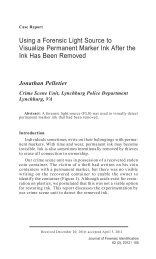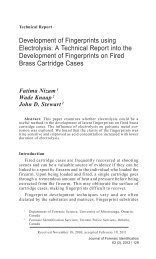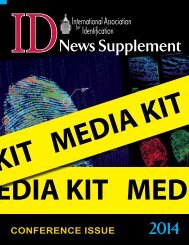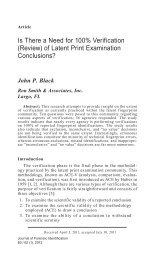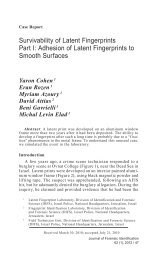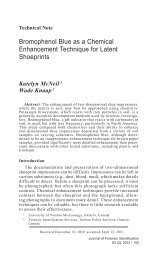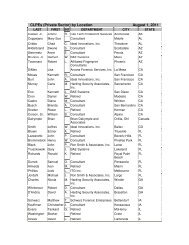Applying Anti-Stokes Phosphors in Development of Fingerprints on ...
Applying Anti-Stokes Phosphors in Development of Fingerprints on ...
Applying Anti-Stokes Phosphors in Development of Fingerprints on ...
You also want an ePaper? Increase the reach of your titles
YUMPU automatically turns print PDFs into web optimized ePapers that Google loves.
Technical Note<br />
<str<strong>on</strong>g>Apply<str<strong>on</strong>g>in</str<strong>on</strong>g>g</str<strong>on</strong>g> <str<strong>on</strong>g>Anti</str<strong>on</strong>g>-<str<strong>on</strong>g>Stokes</str<strong>on</strong>g> <str<strong>on</strong>g>Phosphors</str<strong>on</strong>g> <str<strong>on</strong>g>in</str<strong>on</strong>g><br />
<str<strong>on</strong>g>Development</str<strong>on</strong>g> <str<strong>on</strong>g>of</str<strong>on</strong>g> F<str<strong>on</strong>g>in</str<strong>on</strong>g>gerpr<str<strong>on</strong>g>in</str<strong>on</strong>g>ts <strong>on</strong> Surfaces<br />
Characterized by Str<strong>on</strong>g Lum<str<strong>on</strong>g>in</str<strong>on</strong>g>escence<br />
Bogdan Drabarek 1<br />
Ant<strong>on</strong>i Siejca 2<br />
Jarosław Moszczyński 3<br />
Barbara K<strong>on</strong>ior 1<br />
Abstract: Us<str<strong>on</strong>g>in</str<strong>on</strong>g>g traditi<strong>on</strong>al lum<str<strong>on</strong>g>in</str<strong>on</strong>g>escence methods to develop latent<br />
pr<str<strong>on</strong>g>in</str<strong>on</strong>g>ts becomes problematic when deal<str<strong>on</strong>g>in</str<strong>on</strong>g>g with backgrounds that dem<strong>on</strong>strate<br />
str<strong>on</strong>g lum<str<strong>on</strong>g>in</str<strong>on</strong>g>escence. In such <str<strong>on</strong>g>in</str<strong>on</strong>g>stances, the applicati<strong>on</strong> <str<strong>on</strong>g>of</str<strong>on</strong>g><br />
time-resolved lum<str<strong>on</strong>g>in</str<strong>on</strong>g>escence is c<strong>on</strong>sidered a good soluti<strong>on</strong>. However,<br />
this technique requires the use <str<strong>on</strong>g>of</str<strong>on</strong>g> complicated devices that allow shortlived<br />
background f luorescence to be chopped <str<strong>on</strong>g>of</str<strong>on</strong>g>f from a l<strong>on</strong>ger-lived<br />
f<str<strong>on</strong>g>in</str<strong>on</strong>g>gerpr<str<strong>on</strong>g>in</str<strong>on</strong>g>t lum<str<strong>on</strong>g>in</str<strong>on</strong>g>escence. This paper discusses a new and straightforward<br />
technique for the development <str<strong>on</strong>g>of</str<strong>on</strong>g> latent pr<str<strong>on</strong>g>in</str<strong>on</strong>g>ts that <str<strong>on</strong>g>in</str<strong>on</strong>g>volves us<str<strong>on</strong>g>in</str<strong>on</strong>g>g<br />
pigments with upc<strong>on</strong>versi<strong>on</strong> properties (anti-<str<strong>on</strong>g>Stokes</str<strong>on</strong>g> phosphors). The<br />
method requires an illum<str<strong>on</strong>g>in</str<strong>on</strong>g>ati<strong>on</strong> source that emits <str<strong>on</strong>g>in</str<strong>on</strong>g>frared radiati<strong>on</strong>.<br />
Introducti<strong>on</strong><br />
Lum<str<strong>on</strong>g>in</str<strong>on</strong>g>escence methods that are comm<strong>on</strong>ly used to develop<br />
latent pr<str<strong>on</strong>g>in</str<strong>on</strong>g>ts are ma<str<strong>on</strong>g>in</str<strong>on</strong>g>ly based <strong>on</strong> excitati<strong>on</strong> radiati<strong>on</strong> <str<strong>on</strong>g>in</str<strong>on</strong>g> the<br />
300–700 nm range and optical filtrati<strong>on</strong> <str<strong>on</strong>g>of</str<strong>on</strong>g> the observed latent<br />
image by means <str<strong>on</strong>g>of</str<strong>on</strong>g> edge or bandpass filters [1, 2]. This method<br />
is not efficient <strong>on</strong> surfaces that exhibit str<strong>on</strong>g lum<str<strong>on</strong>g>in</str<strong>on</strong>g>escence.<br />
To overcome this problem, various optoelectr<strong>on</strong>ic devices us<str<strong>on</strong>g>in</str<strong>on</strong>g>g<br />
time-resolved lum<str<strong>on</strong>g>in</str<strong>on</strong>g>escence have been designed. Sophisticated<br />
1<br />
Internal Security Agency, Warsaw, Poland<br />
2<br />
Lasar Elektr<strong>on</strong>ika, Warsaw, Poland<br />
3<br />
University <str<strong>on</strong>g>of</str<strong>on</strong>g> Warmia and Mazury, Olsztyn, Poland<br />
Received December 9, 2010; accepted March 1, 2011<br />
Journal <str<strong>on</strong>g>of</str<strong>on</strong>g> Forensic Identificati<strong>on</strong><br />
28 / 62 (1), 2012
devices, requir<str<strong>on</strong>g>in</str<strong>on</strong>g>g the applicati<strong>on</strong> <str<strong>on</strong>g>of</str<strong>on</strong>g> advanced and usually costly<br />
technology, allow short-lived background f luorescence to be<br />
chopped <str<strong>on</strong>g>of</str<strong>on</strong>g>f from a l<strong>on</strong>ger-lived f<str<strong>on</strong>g>in</str<strong>on</strong>g>gerpr<str<strong>on</strong>g>in</str<strong>on</strong>g>t lum<str<strong>on</strong>g>in</str<strong>on</strong>g>escence [3–6].<br />
The proposed method is based <strong>on</strong> multiphot<strong>on</strong> absorpti<strong>on</strong>, the<br />
upc<strong>on</strong>versi<strong>on</strong> process [7, 8]. It <str<strong>on</strong>g>in</str<strong>on</strong>g>volves the use <str<strong>on</strong>g>of</str<strong>on</strong>g> formulati<strong>on</strong>s<br />
c<strong>on</strong>ta<str<strong>on</strong>g>in</str<strong>on</strong>g><str<strong>on</strong>g>in</str<strong>on</strong>g>g fluorescent pigments <str<strong>on</strong>g>in</str<strong>on</strong>g>c<strong>on</strong>sistent with <str<strong>on</strong>g>Stokes</str<strong>on</strong>g> rule<br />
(e.g., anti-<str<strong>on</strong>g>Stokes</str<strong>on</strong>g> phosphors), as well as <str<strong>on</strong>g>in</str<strong>on</strong>g>frared radiati<strong>on</strong> (IR)<br />
as the excitati<strong>on</strong> source. The method enables the acquisiti<strong>on</strong> <str<strong>on</strong>g>of</str<strong>on</strong>g><br />
lum<str<strong>on</strong>g>in</str<strong>on</strong>g>escent f<str<strong>on</strong>g>in</str<strong>on</strong>g>gerpr<str<strong>on</strong>g>in</str<strong>on</strong>g>ts while elim<str<strong>on</strong>g>in</str<strong>on</strong>g>at<str<strong>on</strong>g>in</str<strong>on</strong>g>g background signals.<br />
This is the effect <str<strong>on</strong>g>of</str<strong>on</strong>g> low-energy IR radiati<strong>on</strong>, which does not<br />
excite lum<str<strong>on</strong>g>in</str<strong>on</strong>g>escence <str<strong>on</strong>g>of</str<strong>on</strong>g> typical dyes.<br />
<str<strong>on</strong>g>Anti</str<strong>on</strong>g>-<str<strong>on</strong>g>Stokes</str<strong>on</strong>g> <str<strong>on</strong>g>Phosphors</str<strong>on</strong>g><br />
Pigments called anti-<str<strong>on</strong>g>Stokes</str<strong>on</strong>g> phosphors bel<strong>on</strong>g to the group <str<strong>on</strong>g>of</str<strong>on</strong>g><br />
lum<str<strong>on</strong>g>in</str<strong>on</strong>g>ophores c<strong>on</strong>sist<str<strong>on</strong>g>in</str<strong>on</strong>g>g <str<strong>on</strong>g>of</str<strong>on</strong>g> fluorides, z<str<strong>on</strong>g>in</str<strong>on</strong>g>c, str<strong>on</strong>tium, or lanthanum<br />
oxides as well as trivalent i<strong>on</strong> admixtures <str<strong>on</strong>g>of</str<strong>on</strong>g> rare-earth<br />
activated compounds, such as thulium, erbium, ytterbium, and<br />
yttrium. They f<str<strong>on</strong>g>in</str<strong>on</strong>g>d their applicati<strong>on</strong> <str<strong>on</strong>g>in</str<strong>on</strong>g> optoelectr<strong>on</strong>ics, biology,<br />
and <str<strong>on</strong>g>of</str<strong>on</strong>g>ten <str<strong>on</strong>g>in</str<strong>on</strong>g> mark<str<strong>on</strong>g>in</str<strong>on</strong>g>g documents and valuables, such as works <str<strong>on</strong>g>of</str<strong>on</strong>g><br />
art. These pigments are sold as powders characterized by high<br />
chemical and temperature stability. Their emissi<strong>on</strong> frequency is<br />
found <str<strong>on</strong>g>in</str<strong>on</strong>g> the l<strong>on</strong>ger absorpti<strong>on</strong> frequency, that is, while excit<str<strong>on</strong>g>in</str<strong>on</strong>g>g<br />
with radiati<strong>on</strong> <str<strong>on</strong>g>in</str<strong>on</strong>g> the range 800–1000 nm, they emit visible<br />
light that depends <strong>on</strong> the phosphor’s compositi<strong>on</strong>. This type<br />
<str<strong>on</strong>g>of</str<strong>on</strong>g> locati<strong>on</strong> <str<strong>on</strong>g>of</str<strong>on</strong>g> absorpti<strong>on</strong> and emissi<strong>on</strong> bands is referred to as<br />
anti-Stoke shifts [7].<br />
The mechanism <str<strong>on</strong>g>of</str<strong>on</strong>g> f luorescence <str<strong>on</strong>g>of</str<strong>on</strong>g> the aforementi<strong>on</strong>ed<br />
pigments is based <strong>on</strong> two- or multiphot<strong>on</strong> absorpti<strong>on</strong>. Optically<br />
active i<strong>on</strong>s with relatively c<strong>on</strong>stant energy levels placed at<br />
regular <str<strong>on</strong>g>in</str<strong>on</strong>g>tervals may absorb two or more phot<strong>on</strong>s <str<strong>on</strong>g>of</str<strong>on</strong>g> the same<br />
wavelength. In the first stage, excitati<strong>on</strong> to a higher metastable<br />
energy level <str<strong>on</strong>g>of</str<strong>on</strong>g> low likelihood <str<strong>on</strong>g>of</str<strong>on</strong>g> emissi<strong>on</strong> takes place. The<br />
sec<strong>on</strong>d stage <str<strong>on</strong>g>of</str<strong>on</strong>g> absorpti<strong>on</strong> <str<strong>on</strong>g>in</str<strong>on</strong>g>volves further excitati<strong>on</strong> to a shortlived<br />
level, from where a radial transiti<strong>on</strong> to a basic level br<str<strong>on</strong>g>in</str<strong>on</strong>g>gs<br />
about fluorescent radiati<strong>on</strong> <str<strong>on</strong>g>of</str<strong>on</strong>g> a shorter length than <str<strong>on</strong>g>in</str<strong>on</strong>g> the case <str<strong>on</strong>g>of</str<strong>on</strong>g><br />
excitati<strong>on</strong> radiati<strong>on</strong>. Depend<str<strong>on</strong>g>in</str<strong>on</strong>g>g <strong>on</strong> the c<strong>on</strong>structi<strong>on</strong> and compositi<strong>on</strong><br />
<str<strong>on</strong>g>of</str<strong>on</strong>g> the upc<strong>on</strong>versi<strong>on</strong> pigment, another mechanism is also<br />
possible, which <str<strong>on</strong>g>in</str<strong>on</strong>g>volves transfer <str<strong>on</strong>g>of</str<strong>on</strong>g> energy between pigment<br />
comp<strong>on</strong>ents <str<strong>on</strong>g>of</str<strong>on</strong>g> various i<strong>on</strong>s [8].<br />
The purpose <str<strong>on</strong>g>of</str<strong>on</strong>g> the research performed at the Internal Security<br />
Agency (Warsaw, Poland) was to exam<str<strong>on</strong>g>in</str<strong>on</strong>g>e the potential <str<strong>on</strong>g>of</str<strong>on</strong>g> IR<br />
radiati<strong>on</strong> <str<strong>on</strong>g>of</str<strong>on</strong>g> the 900–1000 nm range and pigments characterized<br />
Journal <str<strong>on</strong>g>of</str<strong>on</strong>g> Forensic Identificati<strong>on</strong><br />
62 (1), 2012 \ 29
y upc<strong>on</strong>versi<strong>on</strong> <str<strong>on</strong>g>in</str<strong>on</strong>g> the development <str<strong>on</strong>g>of</str<strong>on</strong>g> f<str<strong>on</strong>g>in</str<strong>on</strong>g>gerpr<str<strong>on</strong>g>in</str<strong>on</strong>g>ts as well as<br />
the impact <strong>on</strong> improv<str<strong>on</strong>g>in</str<strong>on</strong>g>g the legibility <str<strong>on</strong>g>of</str<strong>on</strong>g> f<str<strong>on</strong>g>in</str<strong>on</strong>g>gerpr<str<strong>on</strong>g>in</str<strong>on</strong>g>ts developed<br />
through the elim<str<strong>on</strong>g>in</str<strong>on</strong>g>ati<strong>on</strong> <str<strong>on</strong>g>of</str<strong>on</strong>g> background signals.<br />
Materials and Method<br />
Dur<str<strong>on</strong>g>in</str<strong>on</strong>g>g the exam<str<strong>on</strong>g>in</str<strong>on</strong>g>ati<strong>on</strong>, latent pr<str<strong>on</strong>g>in</str<strong>on</strong>g>ts were developed that had<br />
been previously deposited <strong>on</strong> multicolored plastic surfaces and<br />
showed multirange str<strong>on</strong>g lum<str<strong>on</strong>g>in</str<strong>on</strong>g>escence excited with 240–760<br />
nm radiati<strong>on</strong>. On the other hand, these backgrounds did not show<br />
any lum<str<strong>on</strong>g>in</str<strong>on</strong>g>escence when excited with 900–1000 nm radiati<strong>on</strong>.<br />
In the process <str<strong>on</strong>g>of</str<strong>on</strong>g> the development <str<strong>on</strong>g>of</str<strong>on</strong>g> the latent pr<str<strong>on</strong>g>in</str<strong>on</strong>g>ts, a<br />
pigment show<str<strong>on</strong>g>in</str<strong>on</strong>g>g upc<strong>on</strong>versi<strong>on</strong> characteristics, marked as UP54,<br />
as well as its mixture (1:1 ratio) with white B-400 and B-432<br />
powders (BVDA), were used. UP54 pigment is deprived <str<strong>on</strong>g>of</str<strong>on</strong>g> the<br />
adhesi<strong>on</strong> properties <str<strong>on</strong>g>of</str<strong>on</strong>g> typical f<str<strong>on</strong>g>in</str<strong>on</strong>g>gerpr<str<strong>on</strong>g>in</str<strong>on</strong>g>t powder. It dem<strong>on</strong>strates<br />
two k<str<strong>on</strong>g>in</str<strong>on</strong>g>ds <str<strong>on</strong>g>of</str<strong>on</strong>g> lum<str<strong>on</strong>g>in</str<strong>on</strong>g>escence:<br />
• <str<strong>on</strong>g>Stokes</str<strong>on</strong>g>, <str<strong>on</strong>g>in</str<strong>on</strong>g> the yellow range <str<strong>on</strong>g>of</str<strong>on</strong>g> white light at UV excitati<strong>on</strong><br />
<str<strong>on</strong>g>of</str<strong>on</strong>g> approximately 360 nm<br />
• anti-<str<strong>on</strong>g>Stokes</str<strong>on</strong>g>, <str<strong>on</strong>g>in</str<strong>on</strong>g> the green range <str<strong>on</strong>g>of</str<strong>on</strong>g> white light at excitati<strong>on</strong><br />
with 940–980 nm radiati<strong>on</strong> (near IR)<br />
Latent pr<str<strong>on</strong>g>in</str<strong>on</strong>g>ts were developed <strong>on</strong>ly with the UP54 pigment or<br />
its mixture with the previously menti<strong>on</strong>ed f<str<strong>on</strong>g>in</str<strong>on</strong>g>gerpr<str<strong>on</strong>g>in</str<strong>on</strong>g>t powders.<br />
For comparis<strong>on</strong> purposes, the cyanoacrylate method was applied,<br />
and f<str<strong>on</strong>g>in</str<strong>on</strong>g>gerpr<str<strong>on</strong>g>in</str<strong>on</strong>g>ts treated with that method were subsequently<br />
c<strong>on</strong>trasted with fluorescent dyes, such as ardrox, basic yellow,<br />
or safran<str<strong>on</strong>g>in</str<strong>on</strong>g>e.<br />
For the purpose <str<strong>on</strong>g>of</str<strong>on</strong>g> this <str<strong>on</strong>g>in</str<strong>on</strong>g>vestigati<strong>on</strong>, the follow<str<strong>on</strong>g>in</str<strong>on</strong>g>g excitati<strong>on</strong><br />
generat<str<strong>on</strong>g>in</str<strong>on</strong>g>g devices were used:<br />
• illum<str<strong>on</strong>g>in</str<strong>on</strong>g>ati<strong>on</strong> source for acquisiti<strong>on</strong> <str<strong>on</strong>g>of</str<strong>on</strong>g> f<str<strong>on</strong>g>in</str<strong>on</strong>g>gerpr<str<strong>on</strong>g>in</str<strong>on</strong>g>ts<br />
<str<strong>on</strong>g>in</str<strong>on</strong>g> IR Micro Identificati<strong>on</strong> Chamber (MIC) (Lasar<br />
Elecktr<strong>on</strong>ika, Warsaw, Poland); radiati<strong>on</strong> range <str<strong>on</strong>g>of</str<strong>on</strong>g><br />
more than 900 nm (Figure 1)<br />
• xen<strong>on</strong> illum<str<strong>on</strong>g>in</str<strong>on</strong>g>ati<strong>on</strong> source for forensic purposes<br />
(MultiKolor 10Xe, Lasar Elecktr<strong>on</strong>ika, Warsaw,<br />
Poland) <str<strong>on</strong>g>of</str<strong>on</strong>g> 350–1800 nm radiati<strong>on</strong> range<br />
A set <str<strong>on</strong>g>of</str<strong>on</strong>g> edge filters (symbols: KG3+T, 1KG3+T, 2KG3+T )<br />
enabl<str<strong>on</strong>g>in</str<strong>on</strong>g>g excitati<strong>on</strong> IR radiati<strong>on</strong> to be cut <str<strong>on</strong>g>of</str<strong>on</strong>g>f and visible radiati<strong>on</strong><br />
<str<strong>on</strong>g>in</str<strong>on</strong>g> the green range to be passed were used to take photographs <str<strong>on</strong>g>of</str<strong>on</strong>g><br />
f<str<strong>on</strong>g>in</str<strong>on</strong>g>gerpr<str<strong>on</strong>g>in</str<strong>on</strong>g>ts illum<str<strong>on</strong>g>in</str<strong>on</strong>g>ated with IR radiati<strong>on</strong>.<br />
Journal <str<strong>on</strong>g>of</str<strong>on</strong>g> Forensic Identificati<strong>on</strong><br />
30 / 62 (1), 2012
For comparis<strong>on</strong> purposes, f<str<strong>on</strong>g>in</str<strong>on</strong>g>gerpr<str<strong>on</strong>g>in</str<strong>on</strong>g>ts were also recorded<br />
with the use <str<strong>on</strong>g>of</str<strong>on</strong>g> white light and UV radiati<strong>on</strong>. Photographs <str<strong>on</strong>g>of</str<strong>on</strong>g><br />
developed f<str<strong>on</strong>g>in</str<strong>on</strong>g>gerpr<str<strong>on</strong>g>in</str<strong>on</strong>g>ts excited with MIC and MultiKolor 10Xe<br />
illum<str<strong>on</strong>g>in</str<strong>on</strong>g>ati<strong>on</strong> sources were taken with a Can<strong>on</strong> EOS 5D camera,<br />
100 mm f/2.6 macro USM lens, <str<strong>on</strong>g>in</str<strong>on</strong>g> .jpg and .raw formats. An<br />
electro-optical analog-to-digital imag<str<strong>on</strong>g>in</str<strong>on</strong>g>g system for acquisiti<strong>on</strong><br />
<str<strong>on</strong>g>of</str<strong>on</strong>g> f<str<strong>on</strong>g>in</str<strong>on</strong>g>gerpr<str<strong>on</strong>g>in</str<strong>on</strong>g>ts by means <str<strong>on</strong>g>of</str<strong>on</strong>g> time-resolved lum<str<strong>on</strong>g>in</str<strong>on</strong>g>escence<br />
(TRL) [6] was used to record the results with the use <str<strong>on</strong>g>of</str<strong>on</strong>g> the IR<br />
pulse illum<str<strong>on</strong>g>in</str<strong>on</strong>g>ati<strong>on</strong> source. Recorded graphic files were viewed<br />
<str<strong>on</strong>g>in</str<strong>on</strong>g> Adobe Photoshop CS3.<br />
Figure 1<br />
Illum<str<strong>on</strong>g>in</str<strong>on</strong>g>ati<strong>on</strong> source for acquisiti<strong>on</strong> <str<strong>on</strong>g>of</str<strong>on</strong>g> f<str<strong>on</strong>g>in</str<strong>on</strong>g>gerpr<str<strong>on</strong>g>in</str<strong>on</strong>g>ts <str<strong>on</strong>g>in</str<strong>on</strong>g> IR. MIC device<br />
c<strong>on</strong>sists <str<strong>on</strong>g>of</str<strong>on</strong>g> chamber with illum<str<strong>on</strong>g>in</str<strong>on</strong>g>ati<strong>on</strong> source (<str<strong>on</strong>g>in</str<strong>on</strong>g> the middle), power<br />
supply, reducti<strong>on</strong> r<str<strong>on</strong>g>in</str<strong>on</strong>g>gs, filter, and magnify<str<strong>on</strong>g>in</str<strong>on</strong>g>g glass.<br />
Results and Discussi<strong>on</strong><br />
F<str<strong>on</strong>g>in</str<strong>on</strong>g>gerpr<str<strong>on</strong>g>in</str<strong>on</strong>g>ts were developed <strong>on</strong>ly with the use <str<strong>on</strong>g>of</str<strong>on</strong>g> UP54<br />
pigment and its mixture with two BVDA powders. Additi<strong>on</strong>ally,<br />
both the pigment and its mixtures were used for c<strong>on</strong>trast<str<strong>on</strong>g>in</str<strong>on</strong>g>g<br />
f<str<strong>on</strong>g>in</str<strong>on</strong>g>gerpr<str<strong>on</strong>g>in</str<strong>on</strong>g>ts developed with cyanoacrylate.<br />
Reference material c<strong>on</strong>sisted <str<strong>on</strong>g>of</str<strong>on</strong>g> f<str<strong>on</strong>g>in</str<strong>on</strong>g>gerpr<str<strong>on</strong>g>in</str<strong>on</strong>g>ts developed with<br />
cyanoacrylate and c<strong>on</strong>trasted with fluorescent dyes (ardrox,<br />
basic yellow, safran<str<strong>on</strong>g>in</str<strong>on</strong>g>e).<br />
The best results were obta<str<strong>on</strong>g>in</str<strong>on</strong>g>ed while us<str<strong>on</strong>g>in</str<strong>on</strong>g>g UP54 pigment<br />
al<strong>on</strong>e <strong>on</strong> “fresh” f<str<strong>on</strong>g>in</str<strong>on</strong>g>gerpr<str<strong>on</strong>g>in</str<strong>on</strong>g>ts. The pigment poorly deposited <strong>on</strong><br />
older (<strong>on</strong>e-week-old) f<str<strong>on</strong>g>in</str<strong>on</strong>g>gerpr<str<strong>on</strong>g>in</str<strong>on</strong>g>ts. This probably stems from the<br />
fact that the pigment lacks the adhesi<strong>on</strong> properties <str<strong>on</strong>g>of</str<strong>on</strong>g> typical<br />
f<str<strong>on</strong>g>in</str<strong>on</strong>g>gerpr<str<strong>on</strong>g>in</str<strong>on</strong>g>t powder and dem<strong>on</strong>strated poorer adhesi<strong>on</strong> when<br />
Journal <str<strong>on</strong>g>of</str<strong>on</strong>g> Forensic Identificati<strong>on</strong><br />
62 (1), 2012 \ 31
applied to older f<str<strong>on</strong>g>in</str<strong>on</strong>g>gerpr<str<strong>on</strong>g>in</str<strong>on</strong>g>ts. Slightly better results <str<strong>on</strong>g>in</str<strong>on</strong>g> develop<str<strong>on</strong>g>in</str<strong>on</strong>g>g<br />
older f<str<strong>on</strong>g>in</str<strong>on</strong>g>gerpr<str<strong>on</strong>g>in</str<strong>on</strong>g>ts were achieved with use <str<strong>on</strong>g>of</str<strong>on</strong>g> the UP54 pigment<br />
mixture with BVDA white f<str<strong>on</strong>g>in</str<strong>on</strong>g>gerpr<str<strong>on</strong>g>in</str<strong>on</strong>g>t powders. However, these<br />
mixtures dem<strong>on</strong>strated remarkably lower IR lum<str<strong>on</strong>g>in</str<strong>on</strong>g>escence when<br />
compared to the pigment al<strong>on</strong>e. Attempts to c<strong>on</strong>trast cyanoacrylate-developed<br />
f<str<strong>on</strong>g>in</str<strong>on</strong>g>gerpr<str<strong>on</strong>g>in</str<strong>on</strong>g>ts with UP54 al<strong>on</strong>e or its mixtures with<br />
powders did not yield positive results. Figures 2a through 2c<br />
present f<str<strong>on</strong>g>in</str<strong>on</strong>g>gerpr<str<strong>on</strong>g>in</str<strong>on</strong>g>ts developed <strong>on</strong> the same background by means<br />
<str<strong>on</strong>g>of</str<strong>on</strong>g> the cyanoacrylate method followed by c<strong>on</strong>trast<str<strong>on</strong>g>in</str<strong>on</strong>g>g with dyes<br />
(ardrox, basic yellow, safran<str<strong>on</strong>g>in</str<strong>on</strong>g>e) and illum<str<strong>on</strong>g>in</str<strong>on</strong>g>ated with appropriately<br />
suited excitati<strong>on</strong> radiati<strong>on</strong> (350–505 nm), whereas Figure<br />
2d shows a f<str<strong>on</strong>g>in</str<strong>on</strong>g>gerpr<str<strong>on</strong>g>in</str<strong>on</strong>g>t developed with UP54 pigment al<strong>on</strong>e (with<br />
no prior cyanoacrylate treatment) and illum<str<strong>on</strong>g>in</str<strong>on</strong>g>ated with IR radiati<strong>on</strong>.<br />
In these figures, <strong>on</strong>e can easily observe that the background<br />
lum<str<strong>on</strong>g>in</str<strong>on</strong>g>escence <str<strong>on</strong>g>in</str<strong>on</strong>g> IR is significantly lower than <str<strong>on</strong>g>in</str<strong>on</strong>g> the case <str<strong>on</strong>g>of</str<strong>on</strong>g> the<br />
applicati<strong>on</strong> <str<strong>on</strong>g>of</str<strong>on</strong>g> UV and visible light, which c<strong>on</strong>tributes to the fact<br />
that a developed f<str<strong>on</strong>g>in</str<strong>on</strong>g>gerpr<str<strong>on</strong>g>in</str<strong>on</strong>g>t is better when viewed <str<strong>on</strong>g>in</str<strong>on</strong>g> the visibile<br />
range and illum<str<strong>on</strong>g>in</str<strong>on</strong>g>tated with IR radiati<strong>on</strong>.<br />
(a)<br />
(b)<br />
(c)<br />
Figure 2<br />
F<str<strong>on</strong>g>in</str<strong>on</strong>g>gerpr<str<strong>on</strong>g>in</str<strong>on</strong>g>ts developed with cyanoacrylate and c<strong>on</strong>trasted with the<br />
follow<str<strong>on</strong>g>in</str<strong>on</strong>g>g dyes: (a) ardrox; (b) basic yellow; (c) safran<str<strong>on</strong>g>in</str<strong>on</strong>g>e.<br />
(d) F<str<strong>on</strong>g>in</str<strong>on</strong>g>gerpr<str<strong>on</strong>g>in</str<strong>on</strong>g>t developed with UP54 pigment al<strong>on</strong>e.<br />
(d)<br />
Journal <str<strong>on</strong>g>of</str<strong>on</strong>g> Forensic Identificati<strong>on</strong><br />
32 / 62 (1), 2012
Additi<strong>on</strong>al attempts to record f<str<strong>on</strong>g>in</str<strong>on</strong>g>gerpr<str<strong>on</strong>g>in</str<strong>on</strong>g>ts developed with the<br />
UP54 pigment <strong>on</strong> surfaces exhibit<str<strong>on</strong>g>in</str<strong>on</strong>g>g str<strong>on</strong>g fluorescence were<br />
carried out. For this purpose, boxes with f luorescent powder<br />
were used as backgrounds, and they dem<strong>on</strong>strated emissi<strong>on</strong> <str<strong>on</strong>g>in</str<strong>on</strong>g><br />
red and green colors. F<str<strong>on</strong>g>in</str<strong>on</strong>g>gerpr<str<strong>on</strong>g>in</str<strong>on</strong>g>ts deposited <strong>on</strong> these boxes were<br />
developed with the UP54 pigment and photographed with the use<br />
<str<strong>on</strong>g>of</str<strong>on</strong>g> UV radiati<strong>on</strong>, white light, and IR radiati<strong>on</strong>. The best results<br />
were obta<str<strong>on</strong>g>in</str<strong>on</strong>g>ed while apply<str<strong>on</strong>g>in</str<strong>on</strong>g>g IR illum<str<strong>on</strong>g>in</str<strong>on</strong>g>ati<strong>on</strong>, which caused the<br />
excitati<strong>on</strong> <str<strong>on</strong>g>of</str<strong>on</strong>g> a f<str<strong>on</strong>g>in</str<strong>on</strong>g>gerpr<str<strong>on</strong>g>in</str<strong>on</strong>g>t al<strong>on</strong>e and not the background fluorescence<br />
(Figures 3 and 4). Figures 3a and 3b show a f<str<strong>on</strong>g>in</str<strong>on</strong>g>gerpr<str<strong>on</strong>g>in</str<strong>on</strong>g>t<br />
developed with the UP54 pigment <strong>on</strong> a box with red fluorescent<br />
powder and illum<str<strong>on</strong>g>in</str<strong>on</strong>g>ated with visible and IR radiati<strong>on</strong>; Figures<br />
4a and 4b exhibit a f<str<strong>on</strong>g>in</str<strong>on</strong>g>gerpr<str<strong>on</strong>g>in</str<strong>on</strong>g>t developed with the UP54 powder<br />
<strong>on</strong> a box with green fluorescent powder and illum<str<strong>on</strong>g>in</str<strong>on</strong>g>ated with<br />
UV and IR radiati<strong>on</strong>.<br />
(a)<br />
Figure 3<br />
(b)<br />
F<str<strong>on</strong>g>in</str<strong>on</strong>g>gerpr<str<strong>on</strong>g>in</str<strong>on</strong>g>ts developed with UP 54 <strong>on</strong> red background:<br />
(a) white light; (b) IR light.<br />
(a)<br />
Figure 4<br />
(b)<br />
F<str<strong>on</strong>g>in</str<strong>on</strong>g>gerpr<str<strong>on</strong>g>in</str<strong>on</strong>g>ts developed with UP 54 <strong>on</strong> green background:<br />
(a) UV light; (b) IR light.<br />
Journal <str<strong>on</strong>g>of</str<strong>on</strong>g> Forensic Identificati<strong>on</strong><br />
62 (1), 2012 \ 33
F<str<strong>on</strong>g>in</str<strong>on</strong>g>gerpr<str<strong>on</strong>g>in</str<strong>on</strong>g>ts developed with the UP54 pigment were also<br />
successfully recorded by means <str<strong>on</strong>g>of</str<strong>on</strong>g> the optoelectr<strong>on</strong>ic device<br />
TRL, which allows short-lived background f luorescence to<br />
be chopped <str<strong>on</strong>g>of</str<strong>on</strong>g>f from a l<strong>on</strong>ger-lived f<str<strong>on</strong>g>in</str<strong>on</strong>g>gerpr<str<strong>on</strong>g>in</str<strong>on</strong>g>t lum<str<strong>on</strong>g>in</str<strong>on</strong>g>escence,<br />
c<strong>on</strong>sequently lead<str<strong>on</strong>g>in</str<strong>on</strong>g>g to the acquisiti<strong>on</strong> <str<strong>on</strong>g>of</str<strong>on</strong>g> n<strong>on</strong>disturbed latent<br />
pr<str<strong>on</strong>g>in</str<strong>on</strong>g>t images.<br />
C<strong>on</strong>clusi<strong>on</strong><br />
These exam<str<strong>on</strong>g>in</str<strong>on</strong>g>ati<strong>on</strong>s dem<strong>on</strong>strated that upc<strong>on</strong>versi<strong>on</strong> pigments<br />
may f<str<strong>on</strong>g>in</str<strong>on</strong>g>d applicati<strong>on</strong> <str<strong>on</strong>g>in</str<strong>on</strong>g> the development <str<strong>on</strong>g>of</str<strong>on</strong>g> latent pr<str<strong>on</strong>g>in</str<strong>on</strong>g>ts <strong>on</strong><br />
surfaces characterized by str<strong>on</strong>g lum<str<strong>on</strong>g>in</str<strong>on</strong>g>escence. Their advantage<br />
lies <str<strong>on</strong>g>in</str<strong>on</strong>g> their potential to excite lum<str<strong>on</strong>g>in</str<strong>on</strong>g>escence with IR radiati<strong>on</strong>,<br />
whose energy is sufficiently low to avoid excitati<strong>on</strong> <str<strong>on</strong>g>of</str<strong>on</strong>g> other<br />
dyes. Because <str<strong>on</strong>g>of</str<strong>on</strong>g> this feature, <str<strong>on</strong>g>in</str<strong>on</strong>g> many <str<strong>on</strong>g>in</str<strong>on</strong>g>stances, a surface where<br />
a latent pr<str<strong>on</strong>g>in</str<strong>on</strong>g>t was detected rema<str<strong>on</strong>g>in</str<strong>on</strong>g>ed black.<br />
Another advantage <str<strong>on</strong>g>of</str<strong>on</strong>g> upc<strong>on</strong>versi<strong>on</strong> pigments is their ability<br />
to dem<strong>on</strong>strate f luorescence emissi<strong>on</strong> <str<strong>on</strong>g>in</str<strong>on</strong>g> the range visible for<br />
the human eye, which allows the expert to assess the quality <str<strong>on</strong>g>of</str<strong>on</strong>g><br />
a developed pr<str<strong>on</strong>g>in</str<strong>on</strong>g>t visually, with no need to apply specialized<br />
equipment.<br />
Upc<strong>on</strong>versi<strong>on</strong> pigments may also be employed for the<br />
visualizati<strong>on</strong> <str<strong>on</strong>g>of</str<strong>on</strong>g> latent pr<str<strong>on</strong>g>in</str<strong>on</strong>g>ts with the use <str<strong>on</strong>g>of</str<strong>on</strong>g> time-resolved<br />
lum<str<strong>on</strong>g>in</str<strong>on</strong>g>escence.<br />
UP54 pigment and its mixtures with white f<str<strong>on</strong>g>in</str<strong>on</strong>g>gerpr<str<strong>on</strong>g>in</str<strong>on</strong>g>t<br />
powders did not dem<strong>on</strong>strate characteristics <str<strong>on</strong>g>of</str<strong>on</strong>g> a good f<str<strong>on</strong>g>in</str<strong>on</strong>g>gerpr<str<strong>on</strong>g>in</str<strong>on</strong>g>t<br />
powder because <str<strong>on</strong>g>of</str<strong>on</strong>g> their low adhesive property when applied to<br />
older f<str<strong>on</strong>g>in</str<strong>on</strong>g>gerpr<str<strong>on</strong>g>in</str<strong>on</strong>g>ts and the <strong>on</strong>es developed with cyanoacrylate.<br />
Hence, there is a need for a c<strong>on</strong>t<str<strong>on</strong>g>in</str<strong>on</strong>g>uati<strong>on</strong> <str<strong>on</strong>g>of</str<strong>on</strong>g> research aimed at the<br />
producti<strong>on</strong> <str<strong>on</strong>g>of</str<strong>on</strong>g> good-quality powders or suspensi<strong>on</strong>s that c<strong>on</strong>ta<str<strong>on</strong>g>in</str<strong>on</strong>g><br />
mixtures <str<strong>on</strong>g>of</str<strong>on</strong>g> pigments with upc<strong>on</strong>versi<strong>on</strong> properties.<br />
For more <str<strong>on</strong>g>in</str<strong>on</strong>g>formati<strong>on</strong>, please c<strong>on</strong>tact:<br />
Jaroslaw Moszczynski<br />
03-126 Warszawa<br />
ul. Picassa 9 m l9<br />
Poland<br />
jaroslaw_moszczynski@go2.pl<br />
Journal <str<strong>on</strong>g>of</str<strong>on</strong>g> Forensic Identificati<strong>on</strong><br />
34 / 62 (1), 2012
References<br />
1. Menzel, E. R. Laser Detecti<strong>on</strong> <str<strong>on</strong>g>of</str<strong>on</strong>g> Latent F<str<strong>on</strong>g>in</str<strong>on</strong>g>gerpr<str<strong>on</strong>g>in</str<strong>on</strong>g>ts -<br />
Treatment with Phosphorescers. J. For. Sci. 1979, 24 (3),<br />
582–585.<br />
2. Menzel, E. R. F<str<strong>on</strong>g>in</str<strong>on</strong>g>gerpr<str<strong>on</strong>g>in</str<strong>on</strong>g>t Detecti<strong>on</strong> with Lasers, 2nd ed.;<br />
Marcel Dekker: New York, 1999.<br />
3. Murdoch, R. H.; Menzel, E. R. Computer Interfaced Time-<br />
Resolved Lum<str<strong>on</strong>g>in</str<strong>on</strong>g>escence Imag<str<strong>on</strong>g>in</str<strong>on</strong>g>g System. J. For. Sci. 1993,<br />
38 (3), 521–529.<br />
4. Campbell, B. M. Time-Resolved Photography <str<strong>on</strong>g>of</str<strong>on</strong>g> Latent<br />
Pr<str<strong>on</strong>g>in</str<strong>on</strong>g>ts <strong>on</strong> Fluorescent Backgrounds. J. For. Ident. 1993, 43<br />
(4), 368–377.<br />
5. Roorda, R. D.; Ribes, A. C.; Damask<str<strong>on</strong>g>in</str<strong>on</strong>g>os, S.; Dix<strong>on</strong>, A. E.;<br />
Menzel, E. R. A Scann<str<strong>on</strong>g>in</str<strong>on</strong>g>g Beam Time-Resolved Imag<str<strong>on</strong>g>in</str<strong>on</strong>g>g<br />
System For F<str<strong>on</strong>g>in</str<strong>on</strong>g>gerpr<str<strong>on</strong>g>in</str<strong>on</strong>g>t Detecti<strong>on</strong>. J. For. Sci. 2000, 45 (3),<br />
563–567.<br />
6. Moszczyński, J.; Siejca, A.; Ziemnicki, Ł. New System for<br />
the Acquisiti<strong>on</strong> <str<strong>on</strong>g>of</str<strong>on</strong>g> F<str<strong>on</strong>g>in</str<strong>on</strong>g>gerpr<str<strong>on</strong>g>in</str<strong>on</strong>g>ts by Means <str<strong>on</strong>g>of</str<strong>on</strong>g> Time-Resolved<br />
Lum<str<strong>on</strong>g>in</str<strong>on</strong>g>escence. J. For. Ident. 2008, 58 (5), 515–523.<br />
7. Wang, F.; Liu, X. Recent Advances <str<strong>on</strong>g>in</str<strong>on</strong>g> the Chemistry <str<strong>on</strong>g>of</str<strong>on</strong>g><br />
Lanthanide-doped Upc<strong>on</strong>versi<strong>on</strong> Nanocrystals. Chem. Soc.<br />
Rev. 2009, 38, 976–989.<br />
8. Auzel, F. Upc<strong>on</strong>versi<strong>on</strong> and <str<strong>on</strong>g>Anti</str<strong>on</strong>g>-<str<strong>on</strong>g>Stokes</str<strong>on</strong>g> Processes with<br />
f and d I<strong>on</strong>s <str<strong>on</strong>g>in</str<strong>on</strong>g> Solids. Chem. Rev. 2004, 104 (1), 139–174.<br />
Journal <str<strong>on</strong>g>of</str<strong>on</strong>g> Forensic Identificati<strong>on</strong><br />
62 (1), 2012 \ 35



